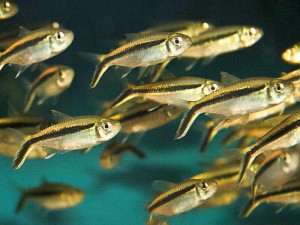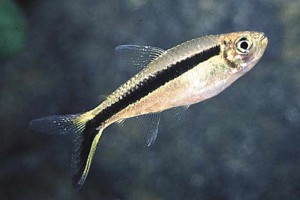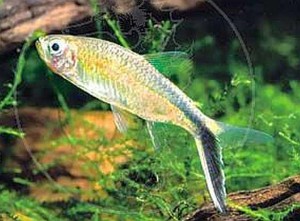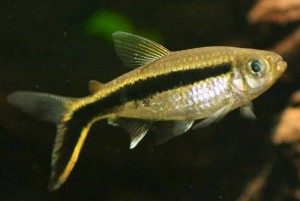The Falsle Penguin Tetra (Thayeria boehlkei) is found in jungle streams and tributaries in the central sections of the Amazon and Rio Tocantins basins, and the Rio Guaporé, in Brazil. They are the most popular of only three species in the genus Thayeria that are all sold as “Penguin Fish“.
Thayeria obliqua was the original Penguin Tetra however, Thayeria boehlkei is more common and is also sold under the same name. The thirdspecies, Thayeria ifati, is rarely available to tropical fish keeping enthusiasts although it is also a beautiful fish.
The False Penguin Tetra (Thayeria boehlkei) is pale to golden in color with a thick vertical black stripe that runs from the tip of thebottom half of the tail, laterally through the body, to the opercle (gill flap) of the fish. The dorsal and anal fins develop red tips and the caudal lobes are edged in an amber color.
In the Thayeria obliqua variety, the black stripe tapers upwards from the lower lobe of the bottom half of caudal fin and completely fades out before it reaches the dorsal fin.
In the third species, Thayeria ifati, the black stripe is only present in the uppermost part of the lower caudal lobe, but it is more clearly defined and extends upwards of the lateral line, beyond the dorsal fin.
All three species swim in an oblique, head up style that is typical of this species.
The False Penguin Tetra is a peaceful schooling species that does best in groups of 6 or more individuals and makes a great addition to any soft water community aquarium. They should be housed in a densely planted, moderately lit tank that is decorated with some smooth river rock, small stones, and driftwood roots with a dark sandy substrate to bring out their colors. A few floating plants
can be added to break up any direct lighting.
These tetras also look great in a natural blackwater biotope setting. Use river sand as the substrate and add a few branches of driftwood, a few handfulls of dried leaves (catappa leaves), and some peat to the aquarium filter to simulate the blackwater conditions necessary. Some tropical fish keeping enthusiasts add a couple handfuls of peat directly to the tank. The peat floats but will sink in a couple of days.
Plants are not generally a feature in the waters where False Penguin Tetras are found, but to create a more effective display, you can add some low light plant species like Java Fern (Microsorum pteropus), Java Moss
(Taxiphyllum barbieri), Cryptocorynes, or Anubias to the biotope tank.
All species of Penguin Tetras will occasionally breed in an aquarium environment but the fry are notoriously difficult to feed. A breeding tank is usually necessary to preserve as many fry as possilbe. Females are distinguished from the males by their more rounded and fuller bodies. The eggs will hatch approximately 12 to 15 hours after being laid and the young can be fed infusoria and newly hatched brine shrimp.
In their natural environment False Penguin Tetras feed on worms, small insects, crustaceans, and zooplankton. In an aquarium environment they should be offered regular feedings of small live, frozen or freeze dried bloodworms, Daphnia, brine shrimp, tubifex, micro pellets, and a high quality flake food.
Thayeria boehlkei collected from the wild require soft acidic water, but most specimens seen in tropical fish shops are farmed in Europe, Florida, or the far East and can be kept in soft to moderately hard water with a neutral pH of 7.0.
False Penguin Tetras are available for sale when they are 3/4″ to 1-1/4″ long.
Minimum Tank Size: 20 gallons
Care Level: Moderate
Temperament: Peaceful
Aquarium Hardiness: Moderately Hardy
Water Conditions: 73-82° F, KH 2-6, pH 5.5-7.0
Max. Size: 3.2″
Color Form: Iridescent Blue, Red
Diet: Omnivore
Compatibility: OK with other small tetras
Origin: South America, farm raised Europe
Family: Characidae
Lifespan: Up to 8 years
Aquarist Experience Level: Beginner to advanced






One Response to “False Penguin Tetra (Thayeria boehlkei)”
Trackbacks/Pingbacks
[…] true Penguin Tetra (Thayeria obliqua) like it’s close relative Thayeria boehlkei, is found in the central sections of the Amazon and Rio Tocantins basins as well as the Rio […]